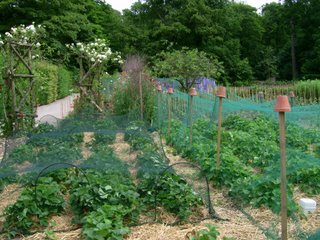Friday, July 28, 2006
This is the ruin called 'the Old Hall'. It was the result of a fight with her fourth and final husband but when he died she abandonned its construction and let it go to ruin in favour of the Hardwick Hall that now stands only a few 100 yards away. The other shots are of the estate and its extent and symmetry. We're off to Stratford Upon Avon next. Stay tuned!





Hardwick Hall - no picture taking was allowed in the building so I have to show you the scale of the estate with outside views. This allee went for a long distance. Everything has to be carefully trimmed and watered. The inside contains alot of tapestries. Bess would wait until there was a distress sale and purchase many when her rich friends were going through insolvency. I found one room smelled really musty but I only noticed it at first. 






Hardwick Hall - I was 15 hours on the bus or walking from where the bus lets you off at Glapwell to the back entry of the estate. This is the home of Bess of Hardwick , a very ambitious woman from the 1500s who married well 4 times and married her children to each successively wealthier new husband's children to keep all the money in the 'family'. At one time she was the second wealthiest woman in England. She also owned Chatsworth House. The Old Hall still stands nearby as a ruin. The backside [below]
 looks surprisingly like the front side.
looks surprisingly like the front side.Thursday, July 27, 2006
Tamworth Castle - this is the non-haunted bedroom, nice and tranquil. The haunted bedroom appropriately placed over the dungeon gave me the spooky effect show below. The other bedroom had outfits in it you could try on and guess who tried an outfit on and had her picture taken by her exchange partner's mother, Margaret Stark. Thank you Margaret!





Tamworth Castle- This is the kind of castle you picture if you are North American with huge thick walls of stone, tiny cut glass windows, turrets, narrow and scary walkways high up, suits of armour, daggers and swords and complete with two ghosts. 





Thursday, July 20, 2006
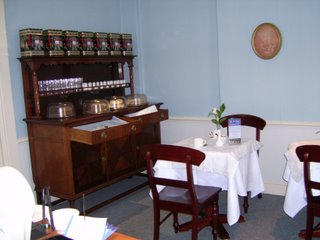

Jane Austen preferred the country life to life in Bath and she did not write about her life there with favour. It was fascinating seeing the dresses and learning how they spent their time and liked their buildings designed. For example for symmetry they would have doors that lead no where so the room would be
'balanced'. There was no running water in the houses which meant no indoor plumbing. Servants brought water and hauled waste away manually.
Astronomer Wm. Herschel was really passionate about double stars and that is what he thought he had found when he discovered Uranus in1781. The museum was his former home, donated by his great-great-great grandaughter. Not only an accomplished scientist who already determined the depth of the craters on our moon in the 1700s with a telescope he developed himself but he was also an accomplished musician and gardener. Everything was in order in the house and it gave me a feeling of tranquility and cerebral contemplation like a great mind was at work within the walls. 








Bath - These are photos of just the Roman portions of the Bath. It was what appealed to me most. I could just imagine the Romans coming out to dip in the waters. Their construction seemed pure, simple and aesthetic to me.
Tuesday, July 18, 2006

The statute of a woman you can see atop the railing in front of the people was actually added by the Victorians. The Roman part is only original under the balcony. In the 1700s Bath decided to raise the street level 17 feet because of flooding. In the 1960s even with that drastic raising of the street level the River Avon rose 33 feet in a flood and swept out the stores on the Pulteney Bridge.
It looks like a movie scene with lots of extras but they were in fact other tourists. The water is so hot from the natural springs of hot water adding a million litres a day that bubbles are rising everywhere. The water is hot to the touch [46 C]. England was hotter than Jamaica the day I went. 


It was interesting seeing the Roman coins tossed down and still in place after 2,000 years. They had Bill Bryson commentary on the audiophones. I really enjoyed seeing the instruments Roman
women used to look beautiful such as tweezers.



It was interesting seeing the Roman coins tossed down and still in place after 2,000 years. They had Bill Bryson commentary on the audiophones. I really enjoyed seeing the instruments Roman
women used to look beautiful such as tweezers.
Monday, July 17, 2006
BATH -This is the Saracens Head Pub where Charles Dickens stayed during his reporter days. Bath was not favourably depicted in the Pickwick Papers. Below is a cherub [bottom left] carved into an alcove. I liked the symmetry of the long corridor of shops with probably a Victorian skylight at the bottom right. 





BATH - The rich people housed in the Royal Crescent, bottom left and the Circus built by the son of the builder for the Royal Crescent wanted to be shielded from the winds off the Atlantic. They were instrumental in having the Marlborough Buildings [top middle] constructed that run N/S and shield the Royal Crescent from the prevailing west winds. No. 1 in the Royal Crescent is a completely restored Georgian. The Circus housed Gainsborough and William Pitt.





Wednesday, July 12, 2006


We were up on a high ridge walking alongside this deep valley. It was blustery but it was beautiful. We had the warm lunch to savour and the beautiful views and we were heading home to the cars after a 5 hour hike over hill and dale. It was so beautiful and fulfilling. Next I'm off to Bath in the SW corner of England. I have to take the train. There is some big festival there this weekend as well so it could be quite crowded. Stay tuned for the pictures next week. Ta ra for now!
Hiking is very civilized in England. You hike straight up 300 feet and find the 'Dicky-Dee' ice cream man with 99 p icecream in a cone with a wedge of chocoate at the bottom of the hill to give you the courage to climb up the next hill and get to the village where the pub is! So this is the village you come to where the pub is and where we ate our lunch in the village square. I felt like the village and the pub were perfect and I had actually died and gone to heaven. The houses were all neat and tidy with perfect gardens and the pub was clean and beautiful. The washrooms had the toilet tank up in the air and fresh flowers at the sink with a beautiful hand towel and scented soap. I had to show you the proverbial stone walls maybe from the Norman times around 1100 AD. The incline on the second picture is for real. We were really walking uphill and the cattle too.
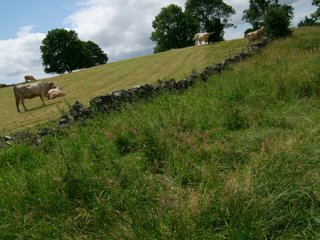






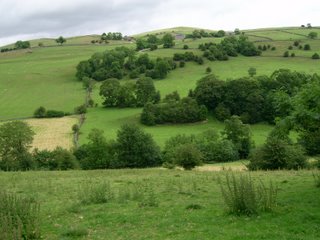
I went hiking with a group that gets together for hiking and skiing. Part of the group had just been hiking in Evian France. The weather looks brooding but it never rained. We went up to a cave called Thor's Cave where bears used to live but now its just a slippery place with scary bits of climbing. There are sheep and cattle in the fields and you need an ordinance map to keep on track. Once we walked through a cottage's side garden but its been allowed since 1840 if not earlier.
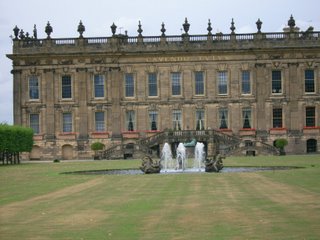

Just before we leave Chatsworth [there were so many more fabulous pictures but I had to be selective and not bore you!] I wanted to point out that they used to have the biggest green house conservatory in the empire. Queen Victoria loved to come for the day and just glory in the greenhouse but it took 3 coal mines going 24 hrs. to keep the greenhouse toasty warm in all seasons and during WWI when coal had to be used for the war effort and labour began to be expensive and just wasn't available the plants died and the greenhouse had to be demolished so they used the stone bases to define a maze which you can go through at Chatsworth now and befuddle yourself. The maze is in the background in the picture to the bottom left.
There are 4 lakes above Chatsworth that a French engineer in the 1700s used to fuel the cascading steps you see up close and in a long view above at the bottom. He also designed this fanastic spout of water that creates an amazing spray. There were little ducklings at the other end. Sir Joseph Paxton who created the gardens described his first four hours at Chatsworth where he came up with the ideas he developed over the next 30 years, met and fell in love with the woman he would marry and be happy with for the rest of his life, and it was only 9 am.






Monday, July 10, 2006
Statuary - so lovely. Hard to know how many 100s of years old they are. Then on the bottom left a decorative garden...the unattainable kind by mere mortals again. And a practical kitchen garden with two layers of netting over the soft fruits -- gooseberries, raspberries and strawberries. On the many buses it took to get there, I bought gooseberries at a farmer's stand and they were luscious. I think the food in England tastes unbelieveably good. 
